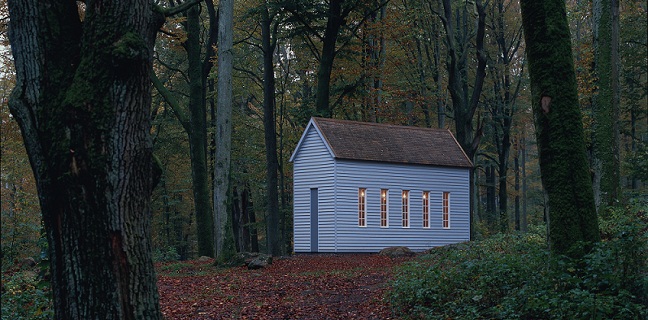
Robert Wilson
(Född/Born 1941, verksam i/works in New York)
A House for Edwin Denby, 2000
Möbler, byggmaterial, högtalare/Furniture, building material, loudspeakers
750 x 250 x 509 cm
Med stöd från/With support from Rappgo AB, Wanås Konst Artlover
For English please scroll down
Till utställningen WANÅS 2000 skapade Wilson två verk tillägnade Edwin Denby (1903–1983), en framstående amerikansk poet och danskritiker som tog sitt liv. A House for Edwin Denby är beläget på en kulle mellan träden söder om dammen. Husets ljusa färg, horisontella träpaneler och långsmala fönster, för tankarna till den enkla byggnadsstil som Shakerrörelsen utvecklade i nordöstra USA under 1800-talet.
Den som närmar sig huset träder in i ett skådespel. Redan på avstånd hör man ljudet från högtalarna i träden som bygger upp ett atmosfäriskt ljudlandskap runtom verket. Inifrån huset hörs Wilsons starka röst recitera en fragmentarisk text, som skrivits speciellt för verket. Det är omöjligt att gå in, men genom fönstren syns en stol och ett bord med en uppslagen bok, samma bok som ska ha varit den sista Denby läste i livet. Stolen står en bit ifrån bordet, som om någon precis har rest sig och hastigt lämnat rummet.
Förutom A House for Edwin Denby skapade Wilson även Edwin’s Last Day i Magasinet. Golvet på andra våningen täcktes med lera, som successivt sprack allteftersom det torkade och besökarna gick på underlaget. Ur högtalarna hördes Wilson läsa en text om Denbys sista dag i livet, skriven av poetens partner Rudy Burckhardt.
Wilson är känd som en ledande konstnär inom avantgardistisk teater och opera. Tillsammans med framstående kompositörer och musiker, som David Byrne, Philip Glass och Tom Waits, har han skapat unika uppsättningar, för vilka han själv ofta har varit regissör, manusförfattare och scenograf.
>>>
For the exhibition WANÅS 2000, Robert Wilson created two works dedicated to Edwin Denby (1903–1983), a prominent American poet and dance critic who ended his own life. A House for Edwin Denby is located on a hill south of the pond. The house’s pale colour, horizontal wooden panels, and tall, narrow windows carry refers to the simple building style developed by the Shaker movement in northeastern USA in the 1800s.
As we approach the house, we are stepping into a drama. The sound coming from speakers in the trees creates an ambient soundscape around the artwork. From inside the house, we hear Wilson’s powerful voice reciting a fragmentary text that was written especially for the work. It is impossible to enter the house, but through the window, we see a chair and table. Resting on the table is an open book, the same book that is said to have been the last one Denby read in his life. The chair stands pushed back from the table, as if someone has just gotten up and hastily left the room.
Besides A House for Edwin Denby, Wilson also created Edwin’s Last Day in the Barn. The floor on the second floor was covered with mud that cracked as it dried and visitors walked on it. Over loudspeakers came Wilson’s voice, reading a text by the poet’s partner Rudy Burckhardt about the last day of Denby’s life.
Robert Wilson is known as a leading artist within avant-garde theatre and opera. In collaboration with prominent composers and musicians such as David Byrne, Philip Glass, and Tom Waits, he has created unique productions for which he has often served as director, scriptwriter, and scenographer.